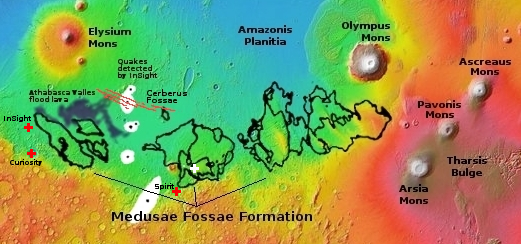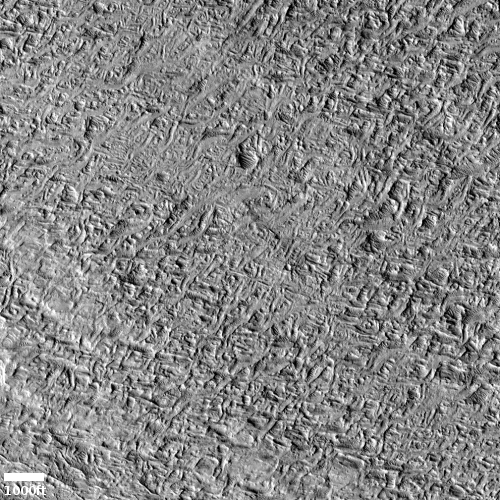Another “What the heck?” formation on Mars
Cool image time! The photo to the right, cropped, reduced, and enhanced to post here, was taken on May 28, 2022 by the high resolution camera on Mars Reconnaissance Orbiter (MRO), and shows what the scientists label “unique terrain.”
I have increased the contrast to bring out the details. It appears that we have a flat plain of criss-crossing ridges that in large areas have somehow gotten flattened across their top. Imagine someone laying plaster on a wall and using a scraper tool to smooth the surface, but only partially. In this case on Mars, our imaginary worker only smoothed the surface a little, and only in some areas. To try to come up with a geological process however to explain this seems daunting.
And what created the criss-crossing ridges? The overview map provides only a little help in answering these questions.

The white cross marks the location of this unique terrain inside the Medusae Fossae Formation, the largest volcanic ash deposit on Mars that is thought to be the source of most of the red planet’s dust. I have featured this region many times previously, because routinely it looks like a Sahara-like desert of wind-shaped hills of sand.
Thus, we may be looking at hardened ash dunes. However, their criss-crossing nature suggests prevailing winds from two different directions. Yet, if the wind shifted 90 degrees wouldn’t the new direction blow away the previously shaped dunes?
And once again, why are the tops of some ridges smoothed, all to the same height?
It is also possible this is a hardened lava flood plain that over time became eroded, both by wind and other processes. Once again, I don’t think there are any known volcanic lava processes that might explain the criss-cross pattern as well as the flattened surfaces.
All in all, another fun feature on Mars that we all can scratch our heads about.
On Christmas Eve 1968 three Americans became the first humans to visit another world. What they did to celebrate was unexpected and profound, and will be remembered throughout all human history. Genesis: the Story of Apollo 8, Robert Zimmerman's classic history of humanity's first journey to another world, tells that story, and it is now available as both an ebook and an audiobook, both with a foreword by Valerie Anders and a new introduction by Robert Zimmerman.
The print edition can be purchased at Amazon or from any other book seller. If you want an autographed copy the price is $60 for the hardback and $45 for the paperback, plus $8 shipping for each. Go here for purchasing details. The ebook is available everywhere for $5.99 (before discount) at amazon, or direct from my ebook publisher, ebookit. If you buy it from ebookit you don't support the big tech companies and the author gets a bigger cut much sooner.
The audiobook is also available at all these vendors, and is also free with a 30-day trial membership to Audible.
"Not simply about one mission, [Genesis] is also the history of America's quest for the moon... Zimmerman has done a masterful job of tying disparate events together into a solid account of one of America's greatest human triumphs."--San Antonio Express-News
Cool image time! The photo to the right, cropped, reduced, and enhanced to post here, was taken on May 28, 2022 by the high resolution camera on Mars Reconnaissance Orbiter (MRO), and shows what the scientists label “unique terrain.”
I have increased the contrast to bring out the details. It appears that we have a flat plain of criss-crossing ridges that in large areas have somehow gotten flattened across their top. Imagine someone laying plaster on a wall and using a scraper tool to smooth the surface, but only partially. In this case on Mars, our imaginary worker only smoothed the surface a little, and only in some areas. To try to come up with a geological process however to explain this seems daunting.
And what created the criss-crossing ridges? The overview map provides only a little help in answering these questions.

The white cross marks the location of this unique terrain inside the Medusae Fossae Formation, the largest volcanic ash deposit on Mars that is thought to be the source of most of the red planet’s dust. I have featured this region many times previously, because routinely it looks like a Sahara-like desert of wind-shaped hills of sand.
Thus, we may be looking at hardened ash dunes. However, their criss-crossing nature suggests prevailing winds from two different directions. Yet, if the wind shifted 90 degrees wouldn’t the new direction blow away the previously shaped dunes?
And once again, why are the tops of some ridges smoothed, all to the same height?
It is also possible this is a hardened lava flood plain that over time became eroded, both by wind and other processes. Once again, I don’t think there are any known volcanic lava processes that might explain the criss-cross pattern as well as the flattened surfaces.
All in all, another fun feature on Mars that we all can scratch our heads about.
On Christmas Eve 1968 three Americans became the first humans to visit another world. What they did to celebrate was unexpected and profound, and will be remembered throughout all human history. Genesis: the Story of Apollo 8, Robert Zimmerman's classic history of humanity's first journey to another world, tells that story, and it is now available as both an ebook and an audiobook, both with a foreword by Valerie Anders and a new introduction by Robert Zimmerman.
The print edition can be purchased at Amazon or from any other book seller. If you want an autographed copy the price is $60 for the hardback and $45 for the paperback, plus $8 shipping for each. Go here for purchasing details. The ebook is available everywhere for $5.99 (before discount) at amazon, or direct from my ebook publisher, ebookit. If you buy it from ebookit you don't support the big tech companies and the author gets a bigger cut much sooner.
The audiobook is also available at all these vendors, and is also free with a 30-day trial membership to Audible.
"Not simply about one mission, [Genesis] is also the history of America's quest for the moon... Zimmerman has done a masterful job of tying disparate events together into a solid account of one of America's greatest human triumphs."--San Antonio Express-News



This is actually quite startling; when I glanced at the image the first thought that popped
into my mind is that this looks like a tablet with cuneiform writing! I don’t know what the
geologists want to call it, but for now I will call it “Cuneiform Terrain.”
Actually, I like that term.
I was thinking “crepey skin terrain”.
Now I don’t have to explain why I thought that.
Thank you.
My reaction was modern art -Texturism
You guys need to get out more, as it’s clear & obvious what caused those terrain features …
Off-roaders.
That works, too.
It’s aliens recreating.
Cool.